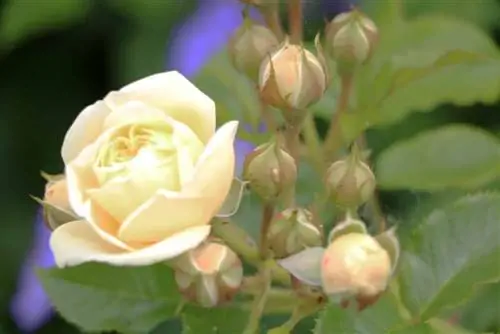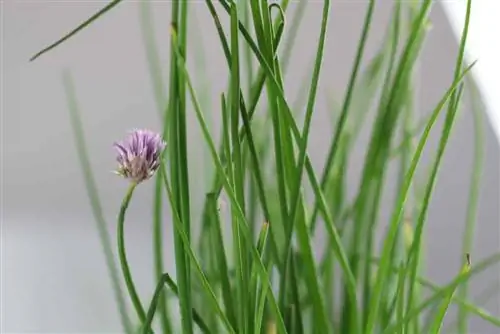- Author admin [email protected].
- Public 2023-12-17 03:39.
- Last modified 2025-06-01 06:48.
Container roses feel best when you carefully ensure that the upper area only has the leaf mass that matches the root size. This requires regular pruning, at the right time and a little differently depending on the type of rose:
Purpose of pruning - more important for container roses than for garden roses
Plants grow, and plants that gardeners help grow are cultivated by humans. So “taken into culture”, according to Wikipedia (de.wikipedia.org/wiki/Kultur) shaped by humans, with the result of a cultural achievement; before our eyes as a machine or work of art, as a mental structure from composition and book to law. Some gardeners are not aware of the fact that they are active in the very roots of human culture: “Culture” began with the cultivation of plants; the root of the word culture is the Latin “cultura”=cultivation, care, agriculture.
We also “shape” the container rose cultivated on the terrace, which qualifies pruning by the gardener as an essential part of plant culture. If a cultivated rose (as it is called in contrast to the wild rose) that has been cultivated by humans is not cut, over time it will transform back into exactly that wild rose, a little more each season. Which can look very beautiful in the garden, which is why the garden culture of a rose could well be limited to cutting back sickly plant mass.
Not an option for container roses, they have to be pruned if they don't want to take up space on the balcony or terrace. But container roses also have to be pruned so that they thrive: a container rose has to make do with a volume of soil that is sometimes dangerously limited compared to the garden location. A rose can only cope with this in the long term if the plant mass in the upper area is constantly adapted to the root development in the pot, so that the rose never has to supply too much plant mass. In addition, correct pruning ensures that the rose takes on a pleasing shape that fits the pot, with many branched shoots that grow close together; with maximum strength and resilience for he althy growth and many new flowers every season.
Cutting container roses correctly: The basics
This is what this correct pruning basically looks like:
- Container roses are pruned in spring when budding is just beginning
- They are cut back all around as far as the current shape requires
- First all sick and dry branches are cut away
- Then all the shoots that grow across, crookedly, too close to others
- If possible, always cut 5 mm above one eye
- Slightly slanted so that rainwater runs off the cut surface, otherwise it could rot
- Later in the year, in preparation for winter, all dried flowers and leaves are removed
- Otherwise they would absorb moisture, which dries very slowly - a feast for mushrooms
- Every rose that grows cheerfully and excessively can be trimmed a little shortly before winter rest
Depending on the type of rose, the cut is a little different in terms of extent and details, more on that below, now let's move on to the basics and the right tools:
Tool
A good pair of rose scissors can significantly extend the life of a rose, so it's worth thinking about the pruning tools:
- A good pair of rose scissors has a bypass blade where the blades slide past each other
- This blade shape, adopted from the pruning shears, cuts while the anvil blade rests on a surface and, in case of doubt, crushes rather than cuts
- Crushing causes ugly, fibrous longitudinal wounds that the rose can hardly close
- The bypass scissors cannot crush, they will only get stuck if a branch is too thick
- This is unlikely to happen with a container rose; it could only develop such thick trunks in house-sized containers
- The prerequisite for working without damaging the rose is a sharp blade, even with bypass scissors
- Unsharp scissors leave a “bark in fringes” that germs and fungi can easily cling to
- Good bypass scissors last a long time, they only need to be sharpened at large intervals, at considerably longer intervals than anvil scissors
- Buy from the manufacturer who also offers grinding and repair services, e.g. B. at a German scissors manufacturer
- The price of scissors starts at around €10; he spends more on the product than on advertising
Correct cutting time
It makes sense that the container rose is cut in spring at the beginning of budding: when the rose is just starting to sprout, its metabolism is working at full speed and it can easily close numerous cuts. In addition, the container rose survives the winter better with full foliage, and if a branch tip suffers from frost, there is “enough material” to cut away in spring. This also applies to shrub roses, for which autumn pruning is often recommended. If you cut a little too late in the fall or winter comes unexpectedly earlier, the cut would cause problems: the rose cannot close the cuts sufficiently, goes into the winter with open wounds and freezes to death more quickly. However, this recommendation is only justified in exceptional cases if the shrub rose has grown so much over the season that it urgently needs to be thinned out in order to survive the winter without fungi and pests in the thick foliage. By the way, the right weather should also be present when pruning: nice and dry and friendly, neither a heavy rain front nor the last late frost should be just around the corner.
Pruning container roses according to variety
A wide variety of roses can be planted in containers; a wide variety of roses are sold as container roses. If a rose is in a pot, it always has to be cut back if you don't want to fill the balcony or terrace with soil at some point and leave it to your rampant rose. However, there are subtle differences when cutting the individual types of roses, which will be discussed below:
- The normal cultivated rose in the pot (the normal pot rose) is cut back every spring
- Depending on whether it should increase or not, a little more or a little less
- But all around, the normal hybrid rose blooms on the shoots that develop after cutting
- For grafted roses, the wild shoots that the rootstock may produce must also be removed
- So all shoots above the grafting point, only from there will the type of rose whose flowers you want to see grow
- When pruning standard roses, all shoots that appear below the crown are removed
- Dwarf roses should be cut back quite heavily to stimulate growth
Flower wonders among the potted roses

As if there wasn't already enough choice when it comes to "normal roses" - there are always new trends among container roses, and these currently include wild roses, shrub-like roses and remontant roses, which require special treatment when pruned would like:
- Wild roses and shrub roses in containers need to be pruned quite heavily so that they remain in sizes suitable for containers
- Not only at the top, but also when repotting, the roots are always cut quite heavily all around.
- But not from the beginning, they develop their flowers on the older branches, so they are first grown to form a small basic structure
- Afterwards only about half of the shoots are cut back so as not to cut away the flowers with the previous year's wood
- The annual pruning can become a rejuvenating pruning by completely removing old shoots to correct the shape
- If the bush grows too densely inside, it is thinned out to prevent fungal attack
- Multiple-flowering (remontant) or permanent-flowering shrub roses and new hybrid rose varieties with multiple flowering are cut back by a third in spring
- Here you can encourage the production of more flowers in the same season if you cut away withered flowers
Cut climbing roses in the pot
Climbing roses can also be kept in pots, they also get special treatment:
- First of all, it's about creating a framework of strong branches by fixing suitable shoots to the trellis and cutting away the rest
- Every spring, all new side shoots are cut down to a few eyes, in the case of single-blooming roses, immediately after flowering
- When remounting climbing roses, you can always remove the withered flowers, then more new flowers will appear
- In spring, these climbing roses get their topiary pruning, during which all winter damage is also cut away
- If a climbing rose gets too tall, you can also cut off the very top, this rejuvenation will only encourage it to grow more vigorously
- Do not cut the climbing roses in spring until night frosts are no longer expected
Conclusion
Pruning roses in pots correctly is anything but rocket science. However, every rose has its own cut if you want to attract the maximum number of flowers from the container roses.






